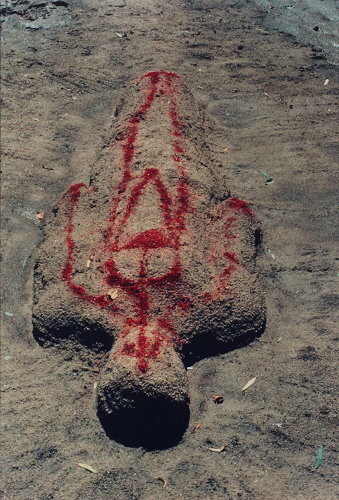Alejandro Hincapie
 |
| Ana Mendieta. Buried. 1973-1977. |
Born in 1948 Havana to a wealthy Cuban family, Mendieta was sent to live in the United States with her sister at the age of 12 as part of a refugee operation called Pedro Pan (Ana Menieta). Her father had supported the communist dictator Fidel Castro, but came to work against him, joined counterrevolutionary forces, and was imprisoned for 18 years for his involvement in the Bay of Pigs invasion (Ana Mendieta). Mendieta and her sister spent their first weeks in the US in refugee camps before being sent to an orphanage in Dubuque, Iowa (Ana Mendieta). She began to study painting at the University of Iowa in 1966 and that same year, she was reunited with her mother and brother. She received her BA in art from the institution in 1969 and an MA in painting three years later (Ana Mendieta).
 |
| Women's Liberation |
This renewed fight for women’s equality and denunciation of cultural and institutionalized patriarchy in the 1960’s and 70’s also coincided with burgeoning new genres of art making such as film and video, land art, performance art, and a new willingness, if not need to use unconventional materials and mediums (The Art Institute of Chicago). Mendieta herself sought more powerful ways of art marking and enrolled into the University of Iowa’s very progressive MFA Intermedia Program where she developed an affinity for the work of sculptors, multimedia artists, and gender and sexuality exploring artists like Lynda Benglis, Bruce Naumen, and Carolee Schneeman (Ana Mendieta). She came to develop hybrid sculptural, performative, and ephemeral works involving her body, the earth, blood, fire, wood, feathers, and other organic materials (Ana Mendieta). On her work, she said, “I have thrown myself into the very elements that produced me. It is through my sculptures that I assert my emotional ties to the earth and conceptualize culture” (The Art Institute of Chicago).
 |
| From Mendieta's Silueta series |
The convergence of the Mendieta’s unique multi-material performative and sculptural work, her own personal story of geographic displacement, and the renewed sense of feminist struggle in the air is best seen in her Silueta series. In sites across Iowa, Mexico, and elsewhere, Mendieta imposed the silhouette of her five-foot body onto the earth (Chadwick 373). Documented through film and photography these impressions were created with “ignited gunpowder, stones, flowers, and fireworks” or created by having Mendieta herself bounded “in strips of cloth and buried in mud and rocks.” (Ana Mendietata, Chadwick 373). On this series, she stated, "I have been carrying on a dialogue between the landscape and the female body (based on my own silhouette)... I am overwhelmed by the feeling of having been cast from the womb (nature). Through my earth/body sculptures I become one with the earth... I become an extension of nature and nature becomes an extension of my body...” (Electronic Arts Intermix). The series allowed Mendieta to explore issues of personal connections with the earth, an issue of relevance to her because of her own geographic displacement from her homeland. But perhaps more than anything, the Silueta series was a commentary on notions of femininity and nature—her impressed female form onto nature itself became archetype natural goddess, establishing a mystical and forever prolific nature onto the work all while rejecting conventions of ideal subject and surface. In using her own body to make impressions upon the earth, Medieta asserted her role as a women with notions of nature as a female force i.e "Mother Nature." Finally, she injected a distinct blend of performative rituality into the series that was drawn from a diverse range of religions, particularly Santeria, a Caribbean and Brazilian mixture of African and Catholic rites through which she was able to inject her own cultural background into her work (The Art Institute of Chicago) (Guerrila Girls 89).
 |
| From Mendieta's Silueta series |
*Image descriptions link to image source.
Works Cited
"Ana Mendieta." Guggenheim Collection Online. The Solomon R. Guggenheim Foundation, n.d. Web. 18 Nov. 2012. <http://www.guggenheim.org/new-york/collections/collection-online/show-full/bio/?artist_name=Ana Mendieta>.
"Ana Mendieta." Electronic Arts Intermix : : Biography. Electronic Arts Intermix, n.d. Web. 18 Nov. 2012. <http://www.eai.org/artistBio.htm?id=373>.
“Ana Mendieta." The Art Institute of Chicago. The Art Institute of Chicago, n.d. Web. 18 Nov. 2012. <http://www.artic.edu/exhibition/mendieta>.
Chadwick, Whitney. Women, Art, and Society. New York, NY: Thames and Hudson, 1990. Print.
Rampton, Martha. "The Three Waves of Feminism." The Magazine of Pacific University. Pacific University, n.d. Web. 18 Nov. 2012. <http://www.pacificu.edu/magazine_archives/2008/fall/echoes/feminism.cfm>.
The Guerrilla Girls' Bedside Companion to the History of Western Art. New York: Penguin, 1998. Print.
No comments:
Post a Comment